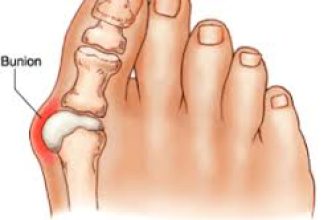Bunions. Even the word “bunions” itself will bring images of painful bony bumps that protrude from the base of your toe’s big toe. If you’re among the many who suffer from this common foot defect It’s more than a snazzy bump. It can cause severe discomfort, restrict your movement, and cause you to have difficulty finding shoes that are comfortable.
Don’t worry! Podiatrists and experts in foot and ankle care can help. In this blog, we’ll dive into rabbitions’ world and explore their causes, and symptoms, and then, the most important thing is how podiatrists are able to help you discover relief and return to your feet with no pain.
Understanding Bunions: A Boney Misalignment
A bunion, also referred to as hallux valgus is a misalignment in the joint that runs from the base of your large toe. The misalignment causes your big toe to be angled inwards towards the toes on the opposite side, and the metatarsal bone (the bone that connects your big foot with your midfoot) is pulled forward, creating the bony bump you notice at the outer edge of your foot.
What Causes Bunions?
The precise cause of bunions isn’t completely understood However, several factors may influence their development:
- Genetics The genetic factors that are passed down through the generations play an important role. If your parents or other close relatives suffer from bunions, you’re more likely to have them.
- Shoes: Wearing shoes that aren’t wide enough or have high heels may put stress on the joint of your big toe, causing it to move out of alignment over time.
- foot type: The feet of people who are flat or have a wider front foot (wide feet)) are more likely to develop bunions.
Health Conditions Medical conditions such as rheumatoid arthritis may be a factor in the formation of a bunion.
Symptoms of Bunions: More Than Just a Bump
While the bunion is the most prominent sign, there are other indicators that could suggest a bunion
- Ailment at the bottom of the large toe particularly in the event of walking
- The swelling, redness or irritation around the bunion
- Finding shoes that are suitable for your feet
- Calluses or corns can form in the toe’s big, or on adjacent toes
- The big toe joint is stiff. joint, restricting its movement
- Need Assistance from Your Podiatrist The Road to Relief
If you’re suffering from bunion-related symptoms that are not cured, it’s important to see an expert in Perth podiatry. Early diagnosis and treatment are essential for managing the condition and avoiding future complications. Here’s what to expect from a podiatric exam for bunions:
- Physical exam: The podiatrist will look at your foot and assess the severity of your bunion, the impact it has on your gait and any other factors that contribute to it.
- Tests for imaging: X-rays might be used to see the joints and bones of your foot, presenting clear images of the bunion’s position and extent.
- Treatment Options: From Comfort Measures to Surgery
The positive side is that podiatrists provide various options for bunion treatment Perth and ease the discomfort. The method you select will depend on the degree of your bunion as well as your lifestyle
- Modes of Treatment: These are often the initial treatment options and can offer substantial relief. They can include:
- Taping and padding: Pads can cushion the bony bump and lessen irritation. Taping is a way to align the big toe and provides assistance.
- Modifications to the shoe: Opting for wider and more comfortable shoes that provide good arch support can dramatically increase comfort and ease the burden on the back of your foot.
- Over-the-counter pain relief: Medications like ibuprofen or acetaminophen can be helpful in managing inflammation and pain.
- Orthotics The custom orthotics are shoe inserts that are specifically designed to fit the specific foot shape of your feet, aid in distributing weight, and improve alignment of your ankle and foot.
- Minimally Invasive Treatments: Injections using cortisone and hyaluronic acids can offer pain relief locally and decrease inflammation.
- Operation: If conservative measures don’t provide enough relief, then surgery may be thought of. Bunionectomy surgery, which involves the treatment of a bony lump as well as realigning the joint is a typical alternative. Podiatrists have a great deal of experience doing minimally invasive bunionectomy procedures which reduce the recovery time and scarring.
Living with Bunions Prevention as well as Long-Term Care
Although bunions aren’t always avoidable, certain actions can reduce the chance of them developing or worsening existing ones
- Choose your footwear carefully: Opt for shoes that have wide toe boxes as well as an arch that is well-supported. Avoid high heels or narrow shoes. heels.
- Maintain your weight in a healthy range: Excess weight puts an additional strain to your foot, especially that big joint in your toe.
- Keep your feet healthy: Regularly stretch your feet and toes and wear supportive footwear even at home.
Bunion Relief: Conservative Measures
Bunions can be painful bone bumps that develop around the base of your toe’s big. There are a variety of methods to relieve the pain without needing surgery. Here are a few important aspects:
- Shoe Gear Don’t wear the tight shoes! Opt for a pair of shoes that are roomy and have a broad toe boxes to alleviate the pressure on the bunion.
- The Padding-Up Method: Bunion pads can be used as buffers between your feet and your shoe, which reduces the friction as well as irritation.
- Pain Management Pain relievers that are available over-the-counter, such as Acetaminophen or Ibuprofen can be used to aid in managing discomfort.
- Ice It Up: Applying ice packs on the area affected can reduce swelling and provide temporary relief from pain.
If the methods you’ve tried don’t provide enough relief, talk to an orthopaedic surgeon (foot physician) to discuss additional possibilities.
Conclusion
Bunions are a frequent source of discomfort, however surgery isn’t the only solution. However, a number of conservative treatments can dramatically improve your living quality.
Start with your shoes. Don’t wear those narrow ones! Find comfortable shoes that have wide toe boxes that allow your toes play naturally. Padding could be your new most trusted friend. Bunions pads that are strategically placed can serve as an extra cushion between your feet and the shoe, which reduces discomfort and friction.
The over-the-counter pain relief medications like ibuprofen or acetaminophen are great allies when it comes to managing discomfort. If pain is a constant source it is a good idea to apply the ice pack covered in towels on the area affected. This will reduce swelling and offer temporary relief.
For long-term management, consider orthotics. These shoe inserts, best designed by a podiatrist will help you realign your foot and ease the pressure on your bunion joint. Be aware that these are general guidelines. Consult a podiatrist to develop an individual treatment plan is essential in order to get the most effective treatment for your particular situation. When you incorporate these preventative steps into your daily routine, you’ll be able to keep the blues of your bunion at bay and return to living life to the fullest.





